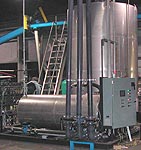Micro Air Separation System (MASS)
 click image to enlarge
click image to enlarge
Overview
Advances in providing high aeration levels and intimate contact between bubbles and the dispersed phase have led to a
unique separation system, the Micro Air Separation System (MASS). The MASS significantly reduces costs, provides unrivalled separation efficiencies, uses
considerably less chemicals, less space and can perform separation operations previously impossible to achieve using traditional Dissolved Air Flotation (DAF) systems.
There are a number of key principles DAF systems must adhere to:
- High surface area micro bubbles must be formed to maximize effluent separation. The MASS bubble size and surface area can be controlled by varying the back-pressure and
airflow rate. Bubble size, generation rate and stability are of key
importance to efficient separation
- Increasing the concentration of bubbles maximizes the lift
performance. The MASS utilizes a portion of the clarified wastewater with air introduced at atmospheric pressure pumped through a pressurized
Micro-Bubble Generator (MBG). The air dissolves and contacts the feed
creating highly aerated water.
- The smaller micro bubbles better adhere to fragile flocculated particles
and typically create a dryer sludge.
- The method of pressure control throughout the circuit is paramount for quality bubble production. The MASS is novel in that the dispersion of micro bubbles in the flotation tank is
greatly improved due to the method of dissolution in the MBG chamber.
Features and Benefits
- Superior separation of contaminants. Up to 95% reduction in Biological Oxygen Demand (BOD), Chemical Oxygen Demand (COD) and Total Suspended Solids (TSS).
- Air aspiration direct from the atmosphere. No air blower or compressor required.
- Small footprint reduces capital costs.
- Minimal maintenance.
- Greater process efficiency. In many cases allows for the reuse of
processed water.
- Modular design and ease of scale-up.
- Reduced chemical consumption.
- More compact sludge.
How does the MASS work?
The MASS system exploits the density difference between two phases
primarily by attaching air bubbles to one phase and floating it away for
collection. This idea is not new, but the method by which it is achieved
using the MASS changes how we think about DAF systems.
The MASS works by dissolving free air from the atmosphere in a micro
bubble generator within the unit, which allows increased air to be dissolved
compared to that of a traditional DAF system. The pressures and forces created ensure intimate mixing of the air and the fluids to be separated, which causes the air to be fully dissolved rather than entrained. The pressures generated within the MASS are up to two times that created in traditional DAF systems thereby, further increasing the amount of air available to strip out suspended solids.
The MASS unit was designed with no moving parts. The air blends with
the water through a specially designed channel, and because this is achieved without moving parts, maintenance costs are reduced significantly.
To realize effective effluent separation, it is often necessary to adjust the electro-potential (pH) of the wastewater, in addition to utilizing an air flotation system. It is also possible to use chemicals such as coagulants and flocculants to help create surfaces or structures that can easily attach to the
micro bubbles. Coagulants are used to bind the particulate matter together and flocculants are used to change the surface tension on the liquid/solid and or liquid/gas interfaces. The combination of all three regimes will almost always bring about separation. However, using the MASS technology, it is usually sufficient to utilize one or two of these regimes and still accomplish a satisfactory result.
Click to see the micro-bubbles generated in the MASS |